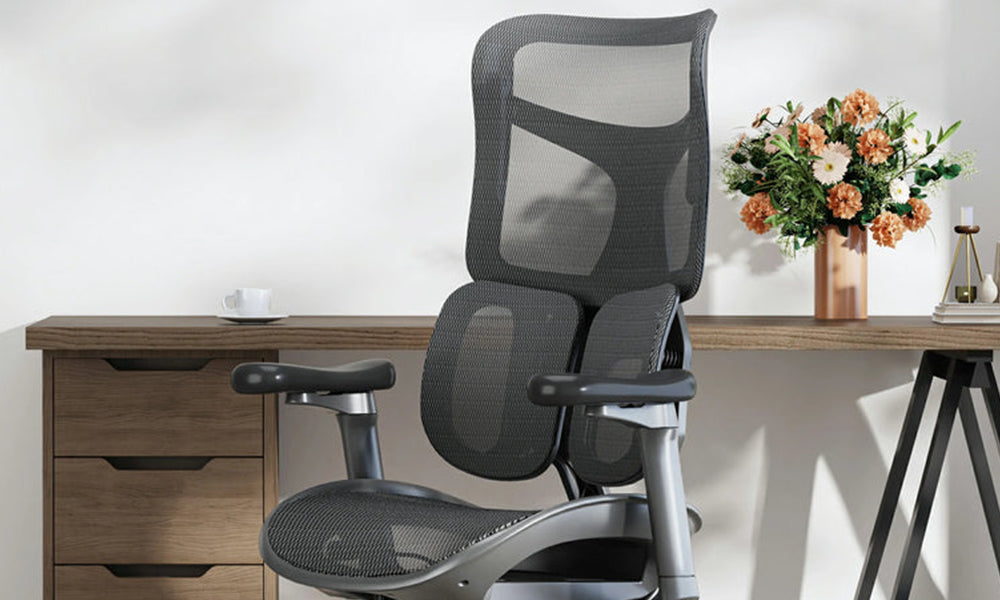In the modern workplace, where long hours are spent seated at desks, the importance of ergonomic chairs cannot be overstated. A well-designed ergonomic chair not only promotes comfort but also contributes to overall health and productivity. However, with a plethora of options available, choosing the right ergonomic chair can be a daunting task. In this comprehensive blog, we will explore various types of ergonomic office chairs, delving into their pros and cons to help you make an informed decision.
High-Back Task Chairs:
Pros:
Neck and Head Support: High-back chairs provide adequate support for the neck and head, reducing the risk of strains.
Improved Posture: The tall backrest encourages a more upright posture, reducing the strain on the spine.
Comfortable for Extended Use: Ideal for individuals who spend long hours working at a desk.
Cons:
Limited Mobility: The high back may limit mobility for tasks that require reaching or turning.
Space Requirements: These chairs may not be suitable for smaller workspaces due to their size.
Mesh Office Chairs:
Pros:
Breathability: Mesh chairs offer excellent ventilation, keeping users cool during extended periods of sitting.
Flexible Support: The mesh material conforms to the user's body shape, providing personalized support.
Modern Aesthetics: Sleek and contemporary designs make mesh chairs visually appealing.
Cons:
Durability Concerns: Some users may worry about the long-term durability of mesh material.
Less Padding: Mesh chairs may have less padding compared to other types, impacting comfort for some users.
Ergonomic Ball Chairs:
Pros:
Active Sitting: Promotes active sitting, engaging core muscles and improving posture.
Versatility: Can be used as both an office chair and for exercise purposes.
Postural Benefits: Encourages a dynamic sitting position, reducing the risk of sedentary-related issues.
Cons:
Adjustment Period: Users may need time to adapt to sitting on a ball, initially finding it uncomfortable.
Limited Back Support: Lacks traditional back support, which might be a concern for some individuals.
Kneeling Chairs:
Pros:
Improved Posture: Encourages a forward-leaning posture that reduces lower back strain.
Engages Core Muscles: Strengthens core muscles while sitting.
Compact Design: Suitable for smaller workspaces.
Cons:
Leg Discomfort: Extended use may lead to discomfort in the shins and knees.
Not Ideal for Everyone: Some users may find kneeling chairs awkward and challenging to use.
Reclining Ergonomic Chairs:
Pros:
Versatility: Can be adjusted for various sitting positions, including reclining for relaxation.
Full Body Support: Provides support for the entire body, including lumbar and neck areas.
Ideal for Breaks: Suitable for short breaks or moments of relaxation during work.
Cons:
Space Requirements: Reclining chairs may need more space compared to standard office chairs.
Cost: High-quality reclining ergonomic chairs can be expensive.
Conclusion
Choosing the right ergonomic office chair depends on individual preferences, work requirements, and health considerations. Each type of chair has its unique advantages and drawbacks, so it's essential to prioritize features that align with your specific needs. Whether you opt for a high-back task chair, a mesh chair, an ergonomic ball chair, a kneeling chair, or a reclining chair, investing in ergonomic furniture can significantly impact your well-being and productivity in the workplace.






Laisser un commentaire
Ce site est protégé par hCaptcha, et la Politique de confidentialité et les Conditions de service de hCaptcha s’appliquent.